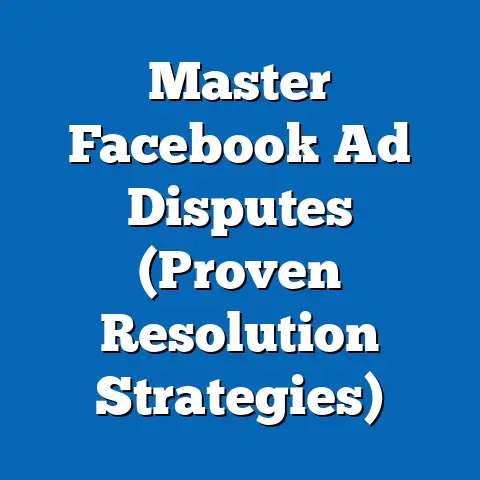Master Facebook Ads Auditing (Expert Tips for Success)
In today’s digital marketing world, it’s easy to get caught up in the whirlwind of new trends and shiny objects. But amidst all the noise, one thing remains constant: the need for sustainable, efficient advertising practices. That’s where Facebook Ads auditing comes in. It’s not just about boosting your ROI; it’s about making your marketing budget work smarter, not harder, and aligning your strategies with your long-term business goals. I’ve seen firsthand how a well-executed audit can transform a struggling campaign into a powerhouse of results, and it all starts with understanding where your money is going and how it’s performing.
Understanding Facebook Ads Auditing
Facebook Ads auditing is essentially a deep dive into your advertising campaigns to identify what’s working, what’s not, and where improvements can be made. It’s a critical process for anyone serious about maximizing their return on investment (ROI) and achieving sustainable growth. Think of it as a health check-up for your ad campaigns, ensuring everything is running smoothly and efficiently.
A comprehensive Facebook Ads audit typically involves examining several key areas:
- Campaign Performance: Analyzing metrics like impressions, clicks, conversions, and cost per acquisition (CPA) to gauge overall effectiveness.
- Audience Targeting: Evaluating whether you’re reaching the right people with your ads and identifying opportunities to refine your targeting.
- Ad Creatives: Assessing the quality and relevance of your ad copy, visuals, and calls-to-action.
- Budget Allocation: Determining if your budget is being allocated effectively across different campaigns and ad sets.
Now, you might be wondering, what’s the difference between a standard audit and an expert-level audit? Well, a standard audit might involve looking at basic metrics and making surface-level adjustments. But an expert-level audit goes much deeper. It involves digging into the data, identifying hidden patterns, and uncovering insights that can lead to significant improvements in performance. For example, I once worked with a client who was seeing decent results from their Facebook Ads campaigns, but after conducting a thorough audit, I discovered that a significant portion of their budget was being wasted on irrelevant placements. By optimizing their placement settings, we were able to reduce their CPA by 30% and significantly improve their overall ROI.
Key Metrics to Analyze
When conducting a Facebook Ads audit, there are several key metrics that you need to pay close attention to:
- Click-Through Rate (CTR): This is the percentage of people who see your ad and click on it. A high CTR indicates that your ad is relevant and engaging to your target audience.
- Cost Per Click (CPC): This is the amount you pay each time someone clicks on your ad. A lower CPC means you’re getting more clicks for your budget.
- Cost Per Acquisition (CPA): This is the amount you pay for each conversion, such as a purchase, lead, or sign-up. A lower CPA means you’re acquiring customers more efficiently.
- Return on Ad Spend (ROAS): This is the amount of revenue you generate for every dollar you spend on advertising. A higher ROAS indicates that your campaigns are profitable.
- Conversion Rate: This is the percentage of people who click on your ad and then complete a desired action, such as making a purchase or filling out a form. A higher conversion rate means your landing page is effective at converting traffic into customers.
Interpreting these metrics effectively is crucial for understanding the performance of your campaigns. For example, a high CTR but low conversion rate might indicate that your ad is attracting the right people, but your landing page is not effectively converting them into customers. Similarly, a low CTR might indicate that your ad is not relevant to your target audience, or that your targeting is too broad.
As for benchmarks, these can vary depending on your industry, target audience, and campaign objectives. However, as a general rule of thumb, you should aim for a CTR of at least 1%, a CPC of less than \$1, a CPA that is lower than your average customer value, and a ROAS of at least 3x.
Analyzing these metrics can also reveal valuable insights into audience behavior and ad effectiveness. For example, by segmenting your data by age, gender, and location, you can identify which demographics are most responsive to your ads. Similarly, by analyzing the performance of different ad creatives, you can identify which visuals and messaging resonate most with your target audience.
Audience Targeting Strategies
Audience segmentation is the cornerstone of successful Facebook advertising. It’s about identifying specific groups of people who are most likely to be interested in your products or services and tailoring your ads to their unique needs and interests.
During the audit process, it’s essential to assess and refine your audience targeting. Here are a few tips to help you do that:
- Use Custom Audiences: Custom Audiences allow you to target people who have already interacted with your business, such as website visitors, email subscribers, or customers. This is a great way to reach people who are already familiar with your brand and are more likely to convert. I’ve found that custom audiences consistently outperform broad targeting options.
- Leverage Lookalike Audiences: Lookalike Audiences allow you to target people who are similar to your existing customers or website visitors. This is a great way to expand your reach and find new customers who are likely to be interested in your products or services. Facebook’s algorithm is surprisingly accurate at identifying these lookalike audiences.
- Refine Interest-Based Targeting: Interest-based targeting allows you to target people based on their interests, hobbies, and behaviors. This is a good way to reach people who are not already familiar with your brand but may be interested in your products or services. However, it’s important to refine your interest-based targeting to ensure that you’re reaching the right people. For example, instead of targeting everyone who is interested in “fitness,” you might want to target people who are interested in “yoga,” “running,” or “weightlifting.”
Facebook’s Audience Insights tool is a valuable resource for enhancing your targeting strategies. It allows you to learn more about your target audience, including their demographics, interests, behaviors, and purchase habits. This information can help you refine your targeting and create ads that are more relevant and engaging to your target audience.
Creative Elements Evaluation
Your ad creatives are the face of your Facebook Ads campaigns. They’re what captures people’s attention and persuades them to take action. That’s why it’s so important to evaluate your ad creatives during the audit process.
Here are some criteria to consider when evaluating your ad copy, visuals, and overall messaging:
- Relevance: Is your ad relevant to your target audience? Does it address their needs, interests, and pain points?
- Clarity: Is your ad clear and easy to understand? Does it communicate your message effectively?
- Compelling: Is your ad compelling and engaging? Does it capture people’s attention and make them want to learn more?
- Call-to-Action: Does your ad have a clear call-to-action? Does it tell people what you want them to do next?
- Visual Appeal: Are your visuals high-quality and visually appealing? Do they complement your ad copy and messaging?
A/B testing is a powerful tool for optimizing your ad creatives. It involves creating multiple versions of your ad with different headlines, visuals, or calls-to-action, and then testing them against each other to see which one performs best. I always recommend A/B testing at least two or three different versions of your ad to identify the winning combination.
Budget and Bidding Strategies
Budget allocation and bidding strategies are critical components of any successful Facebook Ads campaign. During the auditing process, it’s important to assess whether your budget is being allocated effectively and whether your bidding strategies are optimized for your objectives.
The right budget for different campaigns depends on several factors, including your target audience, campaign objectives, and industry. As a general rule of thumb, you should start with a small budget and gradually increase it as you see positive results. It’s also important to allocate your budget across different campaigns and ad sets based on their performance. For example, if one campaign is consistently outperforming others, you might want to allocate more of your budget to that campaign.
When it comes to bidding strategies, you have two main options: automated bidding and manual bidding. Automated bidding allows Facebook’s algorithm to automatically adjust your bids based on your campaign objectives. This is a good option for beginners or for campaigns with a lot of data. Manual bidding, on the other hand, allows you to manually set your bids for each ad set. This is a good option for experienced advertisers or for campaigns with specific performance goals.
Implementing Changes and Measuring Success
Once you’ve completed your Facebook Ads audit, it’s time to take action. The first step is to prioritize the changes that you want to make. Focus on the areas that are likely to have the biggest impact on your campaign performance.
Next, implement your new strategies. This might involve refining your audience targeting, updating your ad creatives, adjusting your budget allocation, or changing your bidding strategies.
Continuous monitoring and re-evaluation are essential for long-term success. Once you’ve implemented your changes, it’s important to monitor your campaign performance closely and make adjustments as needed. This might involve tweaking your targeting, updating your ad creatives, or adjusting your budget allocation.
To measure the impact of your changes, set up tracking mechanisms to monitor your key metrics. This might involve using Facebook Pixel to track conversions on your website, or using third-party analytics tools to track website traffic and engagement. By tracking your metrics, you can see how your changes are affecting your campaign performance and make adjustments as needed.
Conclusion
Mastering Facebook Ads auditing is essential for anyone who wants to achieve sustainable success with Facebook advertising. By taking a systematic approach to auditing your campaigns, you can identify areas for improvement, optimize your budget allocation, and create ads that are more relevant and engaging to your target audience.
In a rapidly changing digital landscape, staying informed and adaptable is crucial for ongoing success. That’s why it’s so important to continuously monitor your campaign performance, re-evaluate your strategies, and seek out new opportunities for improvement. With a little bit of effort and dedication, you can master Facebook Ads auditing and achieve your advertising goals.





